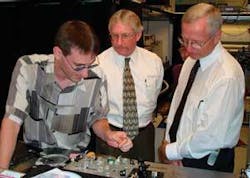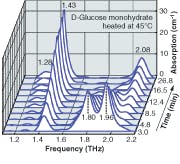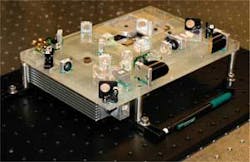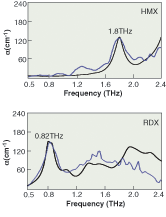TERAHERTZ SPECTROMETRY: Time-domain spectrometers expand toward new horizons
BRIAN SCHULKIN AND X.-C. ZHANG
A conventional terahertz time-domain spectrometer uses ultrafast laser sources ranging anywhere between compact fiber lasers to full-size amplified systems, and with average powers ranging from a few milliwatts to more than 3 W.1 The drive to develop a highly sensitive and selective terahertz spectrometer arises from the desire to detect material “fingerprints” at terahertz frequencies, which are complementary to the more commonly used visible and ultraviolet.
The most detectable materials in the terahertz frequency range include explosives, explosive-related compounds (ERCs), and selected biological materials (see Fig. 1). Many biological and chemical compounds exhibit characteristic absorption features and dispersion due to the vibrational transitions-mostly collective vibrational modes and intermolecular vibrational modes (phonon modes)-within the material. These modes provide material fingerprint information for terahertz sensing. Using terahertz radiation for sensing does have distinct limitations (sensing can be very difficult for most liquid samples, for instance), but the majority of dielectric and gaseous targets are reasonable targets.
By their very nature, amorphous materials (such as glasses, papers, and polymers) do not exhibit any distinct absorption peaks, only broadened absorption features, even at low temperatures. Nevertheless, these materials are often used as containers for illicit substances, so knowledge of their broad absorption properties is essential. These properties vary significantly depending on the material.
A library of different material spectra-ranging from everyday materials to hazardous materials-is currently being assembled by NIST (see webbook.nist.gov/chemistry/thz-ir). Much like the fingerprint database the F.B.I. uses, such a library will enable a suspect material to be identified quickly and efficiently using a terahertz spectrometer.
Long-term applications in biomedicine
Certain foods, beverages, alcohol, caffeine, and even cigarettes can interact with medicines, making them less effective or causing dangerous side effects. Interactions can also occur between some drugs when different drugs are taken during the same period of time. Terahertz spectrometry shows promise for sensing and differentiating between different original drugs, their intermediate states that form during reactions, and even new products that result from interaction.
Terahertz spectrometry was utilized in pharmaceutical research for the first time in 2002.2 It provides a quick, simple, and versatile technique to identify and quantify the polymorphs of pharmaceutical materials. In addition, many solid-state biocompounds have terahertz absorption fingerprints reflecting their intermolecular vibrational modes. The reported biocompounds include nucleotides, amino acids, vitamins, sugars, and other small biomolecules.3-7 Sensing these biocompounds is of significant interest in both biomedical and pharmaceutical research and industries.
With the increasing performance of terahertz spectrometers, spectra can be acquired rapidly enough to observe spectroscopic changes with time and temperature in various solid-state reactions (see Fig. 2).Optimizing terahertz time-domain spectroscopy
Terahertz spectroscopy has been explored since the 1960s, but it was the introduction of terahertz-TDS that marked the terahertz boom, in which the term T-Ray was coined. One of the first-and probably the most impressive-experiments at the time was to use terahertz-TDS to study the chemical composition of flames, an area that could not be touched by other far-IR spectroscopy techniques because of the inability to measure extremely hot objects with a strong blackbody radiation background.8
The two major considerations for optimizing a terahertz spectrometer are sensitivity and selectivity. Sensitivity is very controllable because it relies solely on the signal-to-noise ratio (SNR) and dynamic range (DNR) of the measurement. Reducing the noise level and increasing source power are common ways to improve sensitivity. Selectivity is governed by spectral resolution, which is related to the optical scan length in the THz-TDS system. System bandwidth is also a part of selectivity, which is ultimately controlled by the pulse width of the ultrafast laser and can be limited by either the receiver or detector.
Typically, a terahertz-TDS setup has three major categories of components: optics components include the laser and optical-delay line; terahertz components include the emitter and detector; and control components that are used to modulate terahertz generation, synchronize the delay line, and perform data acquisition. There are numerous choices for each component that generate many combinations that can be used to make an acceptable terahertz spectrometer for different applications.
The most essential, expensive, and sometimes the most bulky component to every terahertz time-domain spectrometer is the pulsed laser source. The laser is used to generate and detect the terahertz radiation. It must output a pulse train with each pulse faster than 100 fs. Powers can range from a mere 10 mW (fiber laser) to several watts (Ti:sapphire).
For most cases, the radiated terahertz power from the emitter (semiconductor or electro-optic crystal) is only related to the laser intensity and material properties. Zinc telluride (ZnTe), periodically poled lithium niobate (PPLN) crystals, and surface emitters fall under this category. Lightly doped p-indium arsenide (InAs) is the best type of surface emitter. The biased photoconductive antenna depends on the laser intensity and the bias voltage. Photoconductive antennas include a variety of electrode structures plated on gallium arsenide (GaAs), low-temperature (LT) GaAs, or radiation-damaged silicon on sapphire (RD-SOS).9 The three most popular photoconductive dipole antenna designs are the Grischkowsky antenna, bowtie antenna, and the photoconductive strip-line.10
Detection of the terahertz radiation can be done in a variety of ways. The two most common methods used are the photoconductive antenna (Grischkowsky type) and ZnTe balanced detection.11 In a free-space optical setup, the Grischkowsky antenna is very sensitive to optical alignment and tight focusing, but fiber-coupled antennas have been developed and are currently available. Zinc telluride balanced detection requires the terahertz beam to copropagate with the probe beam through the crystal, but is less sensitive to alignment than the antenna. The quality of polarization is critical for ZnTe detection; a Glen Thompson polarizer is recommended to ensure the highest polarization quality of the probe beam. Balanced detection is also attractive because the laser noise cancels out when the balanced detectors are optimized. In the optimized case, the measurement noise will be governed only by the shot noise of the photodiodes.
Both the optical-delay line and the optical modulator impose limits on the overall speed of the system. In general, the waveform-acquisition speed of the terahertz spectrometer is thought to be restricted by the traditional mechanical linear translation stage, but in fact the modulation technique is usually responsible. Modulating terahertz emitters that rely solely on laser power require intensity modulation. The most common device to achieve modulation is the optical chopper, which can support modulation frequencies no greater than 5 kHz. There are faster, nonmechanical methods such as acoustic-optic and electro-optic modulators, but in free-space setups they can introduce unnecessary loss and dispersion to the pump beam.
The photoconductive antenna is an attractive choice because modulating the terahertz can be done simply by modulating the bias. When modulating with an AC bias, the terahertz field becomes bipolar and a factor of two in the signal is gained. The higher the modulation frequency, the lower the noise floor, because it significantly decreases with increasing frequency (1/f noise). The pulsed laser is already conveniently modulated as well, defining twice the maximum modulation frequency. A typical modulation frequency is in the 50 to 100 kHz range, which is the limit of the typical lock-in amplifier. Increasing the frequency would require faster (and more expensive) lock-ins.
The optical scanning speed is governed by the acquisition time (lock-in time constant) and the required temporal resolution, which is related to the selectivity. A typical lock-in time constant reaches out to the hundreds of milliseconds, enough to get a high SNR, but too long to scan a waveform in less than 1 s. To achieve high scan rates in the Hertz (with range typically around 150 ps), low time constants (tens of microseconds) must be used, which can only be achieved by increasing the modulation frequency. The limitation to the scan length is restricted by echoes (optical and terahertz pulse reflections) from the experimental setup. Reflections can come from the emitter and receiver, a beamsplitter in the terahertz path, and the sample. The limitation of selectivity is more severe when dealing with thin samples. Terahertz differential time-domain spectroscopy (terahertz-DTDS) was developed for characterizing thin-film semiconductors, but can be used with any thin sample.12
There is no lack of fast-even ultrafast-scanning mechanisms. Optical-delay lines are readily used in optical coherence tomography (OCT) and can be adopted by terahertz-TDS.13 Fast mechanical delay lines include, but are not limited to, a spinning mirror, galvanometer, and the involute stage. These delay stages may not be ideal choices due to their mechanical nature. There are a few nonmechanical solutions. They include fiber stretchers, EO phase modulators, and a pair of pulsed lasers with offset repetition frequencies that scan through each other at their difference frequency.REFERENCES
1. D. Grischkowski et al., J. Opt. Soc. Am. B. 7, 2006 (1990).
2. P.F. Taday et al., J. Pharm. Sci. 92(4) 831 (2002).
3. M. Nagel et al., Appl. Phys. Lett. 80, 154 (2002).
4. L. Genzel, L. Santo, and S.C. Shen, in Spectroscopy of Biological Molecules, C. Sandory and T. Theophanides, eds. (D. Reidel, Boston, 1984), p.609.
5. T.M. Korter, D.F. Plusquellic, Chem. Phys. Lett. 385, 45 (2004).
6. P.C. Upadhya et al., J. Biol. Phys. 29, 117 (2003).
7. M. Walther et al., Chem. Phys. Lett. 332, 389 (2000).
8. R.A. Cheville and D. Grischkowsky, Opt. Lett. 20, 1646 (1995).
9. M. Tani, S. Matsuura, K. Sakai, S. Nakashima, Appl. Opt. 36, 7853 (1997).
10. H. Harde and D. Grischkowsky, J. Opt. Soc. Am. B 8, 1642 (1991).
11. Q. Wu and X.-C. Zhang, Appl. Phys. Lett. 71, 1285 (1997).
12. Z. Jiang, M. Li, and X.-C. Zhang, Appl. Phys. Lett. 76, 3221 (2000).
13. M. Tani, S. Matsuura, K. Sakai, S. Nakashima, Appl. Opt. 36, 7853 (1997).
BRIAN SCHULKIN is a graduate student and X.-C. ZHANG heads the Center for Terahertz Research, Rensselaer Polytechnic Institute, Troy, NY 12180; e-mail: [email protected]; www.rpi.edu/terahertz.



